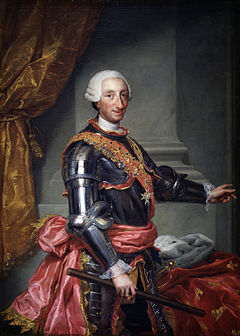| Preceded by Fernando VI |
Rey de España 1759-1788 |
Succeeded by Carlos IV |
Biography
Charles III (Spanish: Carlos; Italian: Carlo; 20 January 1716 – 14 December 1788) was the King of Spain and the Spanish Indies from 1759 to 1788. He was the fifth son of Philip V of Spain, but eldest by his second wife, Elisabeth Farnese. In 1731, the 15-year-old Charles became the Duke of Parma and Piacenza, as Charles I, on the death of his childless granduncle Antonio Farnese.
In 1734, as Duke of Parma, he conquered the kingdoms of Naples and of Sicily, and was crowned king on 3 July 1735, reigning as Charles VII of Naples and Charles V of Sicily. In 1738 he married Princess Maria Amalia of Saxony, an educated, cultured woman who gave birth to 13 children, eight of whom reached adulthood. Charles and Maria Amalia resided in Naples for 19 years; she died in 1760.
Upon succeeding to the Spanish throne on 10 August 1759, Charles, a proponent of enlightened absolutism, on 6 October 1759 abdicated the Neapolitan and Sicilian thrones in favour of Ferdinand, his third surviving son, who became Ferdinand I of the Two Sicilies.
As king of Spain Charles III tried to rescue his empire from decay through far-reaching reforms such as weakening the Church and its monasteries, promoting science and university research, facilitating trade and commerce, modernizing agriculture and avoiding wars. He never achieved satisfactory control over finances, and was obliged to borrow to meet expenses. His reforms proved short-lived and Spain relapsed after his death, but his legacy lives on to this day.[1]
Historian Stanley Payne states Charles III:
"was probably the most successful European ruler of his generation. He had provided firm, consistent, intelligent leadership. He had chosen capable ministers....[his] personal life had won the respect of the people."
Sources
It may be possible to confirm family relationships with Carlos III by comparing test results with other carriers of his Y-chromosome or his mother's mitochondrial DNA. Y-chromosome DNA test-takers in his direct paternal line on WikiTree:
- Louis XVII (Bourbon) de France
 :
Y-Chromosome Test 16 markers, haplogroup R-Z381, MitoYDNA ID Z10012 [compare]
:
Y-Chromosome Test 16 markers, haplogroup R-Z381, MitoYDNA ID Z10012 [compare]
- Philip (Schleswig-Holstein-Sonderburg-Glücksburg) Mountbatten
 :
Mitochondrial DNA Test HVR1 and HVR2, haplogroup H1af, MitoYDNA ID Z10699 [compare]
:
Mitochondrial DNA Test HVR1 and HVR2, haplogroup H1af, MitoYDNA ID Z10699 [compare] - Alexandra Feodorovna (Hesse-Darmstadt) Romanov
 :
Mitochondrial DNA Test Full Sequence, haplogroup H1af2, MitoYDNA ID Z10396 [compare]
:
Mitochondrial DNA Test Full Sequence, haplogroup H1af2, MitoYDNA ID Z10396 [compare]
-
~0.39%
Ari Ehrlich
 :
23andMe, GEDmatch MV7674932 [compare], yourDNAportal ARI1c3291c9
+
AncestryDNA, GEDmatch MV7674932 [compare]
:
23andMe, GEDmatch MV7674932 [compare], yourDNAportal ARI1c3291c9
+
AncestryDNA, GEDmatch MV7674932 [compare]
Have you taken a DNA test? If so, login to add it. If not, see our friends at Ancestry DNA.
 Isabelle (Rassinot) Martin
Isabelle (Rassinot) Martin
Featured National Park champion connections: Carlos III is 14 degrees from Theodore Roosevelt, 18 degrees from Stephanus Johannes Paulus Kruger, 16 degrees from George Catlin, 15 degrees from Marjory Douglas, 24 degrees from Sueko Embrey, 16 degrees from George Grinnell, 20 degrees from Anton Kröller, 17 degrees from Stephen Mather, 21 degrees from Kara McKean, 18 degrees from John Muir, 6 degrees from Victoria Hanover and 27 degrees from Charles Young on our single family tree. Login to find your connection.
B > Bourbon | D > de Borbón y Farnese > Carlos (Bourbon) de Borbón y Farnese
Categories: House of Bourbon | Spanish Nobility | House of Capet



